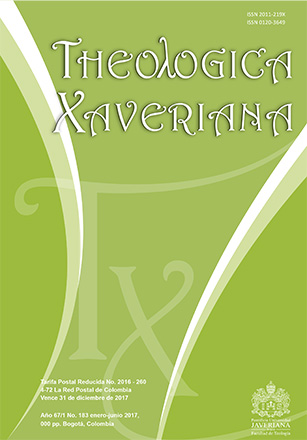Abstract
This study aims at elucidating the meaning of Edith Stein’s notion of “certainty of being”. As an original phenomenon, the latter has always been critically approached by both Philosophy and Theology. Nonetheless, Stein provides a philosophically rigorous understanding of what “certainty of being” means, in which the mystery of the finite spirit –always exposed to not-being for its lack of shelter– is seized by the infinite Spirit. Although related to both human reason and feelings, the “certainty of being” transcends them, for it implies something new beyond clear and distinct ideas, and mere emotions.
Abbagnano, Nicola. “Certidumbre o certeza”. En Diccionario de filosofía (2a. ed.), dirigido por N. Abbagnano, 159-161. Mexico-Buenos Aires: Fondo de Cultura Ecónomica, 1966.
Berger, Peter y Anton Zijderveld. In Praise of Doubt. How to Have Convictions Without Becaming a Fanatic. New York: Harper Collins Publishers, 2009.
Fermandois, Eduardo. “Ni fundacionismo ni coherentismo. Una lectura antropológica de Sobre la certeza”. Revista de Filosofía 69 (2013): 99-117.
Francisco. “La certeza de la resurrección”. Humanitas 20 (2015): 625-626.
Habermas, Jürgen. El discurso filosófico de la Modernidad. Buenos Aires-Madrid: Katz, 2008.
Halbfass, Wilhem. Historisches Wörterbuch der Philosophie. Vol. 3. Basel-Stuttgart: Schwabe, 1971.
Marion, Jean-Luc. Certitudes Négatives. Paris: Grasset, 2010.
Meis, Anneliese. “El espíritu finito, anticipado por el Espíritu infinito en la obra Potenz und Akt de Edith Stein”. Scripta Theologica 47 (2015): 9-40.
Naaykens, Bernard. “El fundamento de nuestra certeza”. Scripta Theologica 12 (1980): 171-194.
Stein, Edith. “Acto y potencia”. En Obras completas, por E. Stein, Vol. III, 225-536. Burgos: Monte Carmelo 2005.
_____. Anhang: Martin Heideggers Existenzphilosophie. Die Seelenburg. Introducido y editado por Andreas Uwe Müller. Freiburg- Basel-Wien: Herder, 2006.
_____. “Castillo interior”. Anexo de Ser infinito, ser eterno. En Obras completas, por E. Stein, Vol. III, 1113-1136. Burgos: Monte Carmelo 2005.
_____. Ciencia de la cruz. Estudio sobre San Juan de la Cruz. Burgos: Monte Carmelo, 1989.
_____. “Causalidad psíquica”. En Obras completas, por E. Stein, Vol. II, 217-329. Burgos: Monte Carmelo 2005.
_____. “Die Seelenburg”. En Anhang: Endliches und ewiges Sein. Versuch eines Aufstiegs zum Sinn des Seins, 501-525. Freiburg: Herder, 2006.
_____. Der Aufbau der menschlichen Person. Vorlesung zur philosophischen Anthropologie. Freiburg-Basel-Wien: Herder, 2004.
_____. Einführung in die Philosophie. Freiburg-Basel-Wien: Herder, 2004.
_____. Endliches und ewiges Sein. Versuch eines Aufstiegs zum Sinn des Seins. Freiburg-Basel-Wien: Herder, 2006.
_____. Freiheit und Gnade und weitere Texte zu Phänomenologie und Ontologie (1917 bis 1937). Freiburg- Basel-Wien: Herder, 2014.
_____. Gesamtausgabe, hrsg Internationales Edith Stein. 26 vols. Freiburg-BaselWien: Herder, 2004-2008.
_____. “Introducción a la filosofía”. En Obras completas II. Escritos filosóficos. Etapa fenomenológica, por E. Stein, 657-913. Burgos: Monte Carmelo, 2005.
_____. Kreuzeswissenschaft. Sudie über Johannes vom Kreuz. Freiburg-Basel-Wien: Herder, 2003.
_____. La estructura de la persona humana. Madrid: Biblioteca de Autores Cristianos, 2002.
_____. “Naturaleza, libertad y gracia”. En Obras completas, por E. Stein, Vol. III, 55-128. Burgos: Monte Carmelo 2005.
_____. Potenz und Akt. Studien zu einer Philosophie des Seins. Freiburg-Basel-Wien: Herder, 1998.
_____. “Psychische Kausalität”. En Beiträge zur philosophischen Begründung der Psychologie und der Geisteswissenschaften, por E. Stein, 1-109. Freiburg: Herder, 2010.
_____. ¿Qué es filosofía? Un diálogo entre Edmund Husserl y Tomás de Aquino. Madrid: Encuentro, 2001.
_____. “Ser finito y ser eterno. Ensayo de una ascensión al sentido del ser”. En Obras completas, por E. Stein, Vol. III, 587-1112. Burgos: Monte Carmelo 2005.
_____. Sobre el problema de la empatía. Madrid: Trotta, 2004.
_____. “Was ist Philosophie? Ein Gespräch zwischen Edmund Husserl und
Thomas von Aquino (1928)”. En Freiheit und Gnade und weitere Beiträge zu Phänomenlogie und Ontologie (1917-1937), por E. Stein, 91-142. Freiburg-Basel-Wien: Herder, 2014.
_____. Zum Problem der Einfühlung. Freiburg-Basel-Wien: Herder, 2008.
Wittgenstein, Ludwig. Sobre la certeza. Barcelona: Gedisa, 1988.
This journal is registered under a Creative Commons Attribution 4.0 International Public License. Thus, this work may be reproduced, distributed, and publicly shared in digital format, as long as the names of the authors and Pontificia Universidad Javeriana are acknowledged. Others are allowed to quote, adapt, transform, auto-archive, republish, and create based on this material, for any purpose (even commercial ones), provided the authorship is duly acknowledged, a link to the original work is provided, and it is specified if changes have been made. Pontificia Universidad Javeriana does not hold the rights of published works and the authors are solely responsible for the contents of their works; they keep the moral, intellectual, privacy, and publicity rights.
Approving the intervention of the work (review, copy-editing, translation, layout) and the following outreach, are granted through an use license and not through an assignment of rights. This means the journal and Pontificia Universidad Javeriana cannot be held responsible for any ethical malpractice by the authors. As a consequence of the protection granted by the use license, the journal is not required to publish recantations or modify information already published, unless the errata stems from the editorial management process. Publishing contents in this journal does not generate royalties for contributors.



